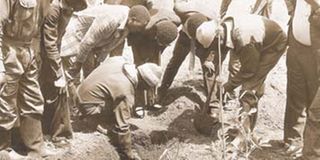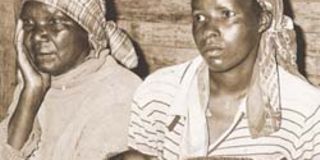Premium
Police admitted they shot Mbaraka dead

The search for Mr Mbaraka's body in the Eldoret municipal cemetery, but the remains were never found.

Mr Mbaraka's mother, Mrs Teresia Nyayoyo Mbaraka, and his wife Naomi Waithera at their home in Kiambu in June, 1987.
When lawyer Obadiah Thiong'o Ngwiri returned to Kenya after studying and practising law in Canada for 16 years, he was virtually a stranger in his country of birth.
He did not know where to start or any lawyer who could show him the ropes after he enrolled as an advocate of the High Court in 1980.
"I went to the High Court in Nairobi and was assigned what lawyers call pauper briefs (cases in which the Government appoints a lawyer to represent a client who cannot raise legal fees)."
Within a short time, Mr Ngwiri was handling many cases, majority of them dealing with murder. The High Court paid him Sh200 every day he appeared in court to represent a client.
"I later started getting clients of my own because my name was frequently appearing in newspapers," he recalled recently.
When the High Court pushed another pauper brief to Mr Ngwiri in 1983, he did not know that the client he was going to represent would propel him to international fame.
His new client – Mr Stephen Mbaraka Karanja – became an international icon of human rights abuse by the Kenyan police.
His case also exposed police brutality and the dark history of the Kenya police. This happened at a time when those who dared question the actions of security agents or the Kanu regime were risking not just their livelihoods but also their skins.
Mr Ngwiri was to represent Mr Mbaraka who had been charged with the murder of a resident of Nyambari Village in Uplands, about five kilometres from his (Mbaraka's) home in Kirenga Village, Kiambu District.
"I successfully managed to convince the then chief magistrate, Mr Fida Hussein Abdallah, to dismiss the case for lack of evidence," the lawyer said.
"Mr Mbaraka went away and I went on with my work," he recalled.
Mr Ngwiri heard of Mr Mbaraka again in 1987 when he had trouble with the police.
"His relatives came to my office and told me that Mr Mbaraka had been picked up by the police at Kibera Laini Saba bus stop," he said.
The lawyer wrote a letter to the then director of CID, Mr Noah arap Too, to complain about the arrest of his client and find out where he was being held.
Mr Too's response was curt. "If you knew what type of a character your client is, I am sure you would not be pestering me with these silly threats," Mr Too wrote on April 13, 1987.
Mr Ngwiri threatened to sue the Government and Mr Too for the unlawful detention of Mr Mbaraka. But the CID director said he was not admitting liability. The word not was written in capital letters and underlined to drive the point home.
In an affidavit sworn on June 2, 1987, when the case had generated a lot of heat, Mr Too explained that he wrote the letter before he received news of Mr Mbaraka's shooting.
He said when he received the news, he directed officers at Eldoret police station to carry out investigations and forward the file to him.
The outcome of the investigations has never been made public.
"Mbaraka's family was poor and they had no money to hire a lawyer. But Mr Too's rude letter made me vow that I would fight on with or without payment," Mr Ngwiri said.
"I decided to abide by the oath I took when enrolling to be an advocate; to defend my clients without fear or favour. I had a right to defend my client."
Through Mr Ngwiri, Mr Mbaraka's wife, Mrs Naomi Waithera Mbaraka, went to court on May 20, 1987, and asked Mr Justice Derek Schofield to order Mr Too to release her husband.
"I did not know that I was opening a pandora's box. All hell broke loose. Top Government officials were furious, he said. How could the lawyer sue the CID director and the State?" they asked.
Mr Ngwiri's employee, Ms Janet Mulwa, developed cold feet and opted to pull out. But the lawyer was undeterred.
"I took charge of the case and started appearing in court personally," he said.
Mrs Mbaraka had asked the court to order the police to release her husband believing he was alive and in police custody.
But she was in for a shock. On June 5, 1987, State counsel Njenga Muchiru disclosed that Mr Mbaraka had been shot dead in an Eldoret forest as he allegedly tried to escape from police officers. It was alleged that he had offered to show them where a pistol had been hidden.
The revelation, however, came two months after the event.
Mr Muchiru told the stunned court that Mr Mbaraka's body was later buried at the Eldoret municipal cemetery "after the investigators failed to locate his next of kin".
Mr Justice Schofield, clearly shocked, described the police failure to inform Mr Mbaraka's family of his death as "callous in the extreme".
He immediately ordered the police to exhume the body and hand it over to Mr Mbaraka's family for burial.
But another hitch cropped up. The body could not be found even after 24 graves were dug up at the cemetery.
On the first day, June 25, 1987, they excavated 19 graves, seven of them twice, as they tried to trace the missing body.
Mr Karanja's relatives and journalists watched in horror as grave diggers, hired for Sh450 by Mr Ngwiri shovelled soil from one grave after another and bared decomposing corpses.
Five other graves were uncovered the next day before the team threw in the towel.
The police and the doctors declared the body could not be at the cemetery.
Mr Ngwiri said they went back to Mr Justice Schofield to report their findings. By this time, Mr Bernard Chunga had taken over the case as assisting state counsel.
Mr Chunga now told the judge that he had been told by the police that the body could be found in the Eldoret cemetery's Grave One or Two.
Mr Justice Schofield then ordered the police and the pathologists to go back to Eldoret to exhume the bodies in the two graves.
"They pulled out two decomposed bodies and ferried them to the City Mortuary in Nairobi for reconstruction," he said.
The then Chief Government pathologist, Dr Jason Kaviti, and his then deputy, a Dr Kariuki, took charge in Nairobi.
"It was grisly affair as the mortuary attendants cleaned the rotten bodies and reconstructed them. I smoked several packets of cigarettes to stifle the irritating stench. After enduring grisly scene and the stench, the pathologists announced that none of the bodies was Mbaraka's," he said.
Mr Ngwiri said the then Nairobi provincial police chief, Mr G.K. Kinoti, remained at the mortuary through out the exercise and kept telling him to abandon the case.
"I told him that would never happen. All along, the police and the pathologists knew Mbaraka's body was not buried in Eldoret and they wanted to frustrate us so that we could drop the case," the lawyer said.
The matter took another twist when the then Chief Justice, Mr Cecil Miller, abruptly disqualified Mr Justice Schofield from hearing the case in August 1987.
When Mr Ngwiri returned to his office, he found Mr Justice Schofield had left a message asking him to go to the judge's office at the law courts at 2pm.
"When I walked into the judge's chambers, he was very angry. He was standing and he was dictating a resignation letter to his shocked secretary," Mr Ngwiri recalled.
He went on: "He told me I would not win the Mbaraka case but asked me to fight on so that the world would know about the injustices in Kenya. I told him I would not quit."
When the court came from the August vacation, the Mbaraka case was assigned to Mr Justice Akilano Akiwumi.
"I refused to attend court and judge Akiwumi struck out the case in the Government's favour. That ended any hope of ever finding Mr Mbaraka alive or his remains," Mr Ngwiri said.

